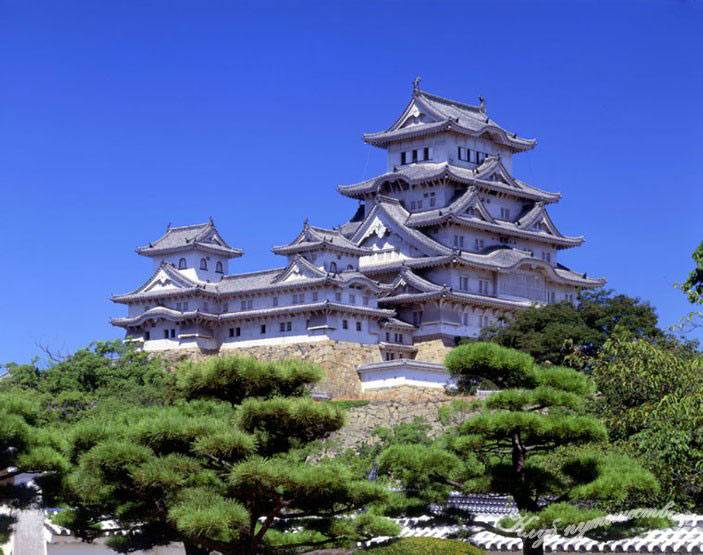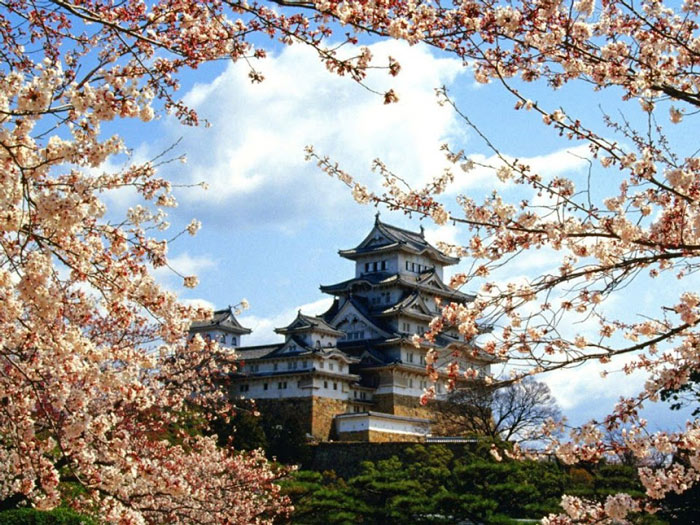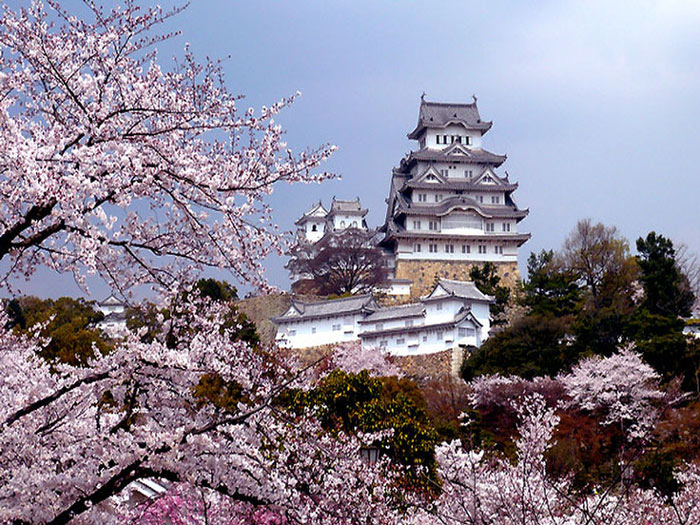Himeji Castle - World Cultural Heritage in Japan
Unesco's Science, Education and Cultural Organization has recognized Japan's Himeji Castle as a World Cultural Heritage in 1993.

Himeji Castle is one of the oldest and most famous historical sites in Japan, considered by the Japanese to be his National Security . The castle is also a castle in the top of the three most precious buildings in Japan (the Three Great Kingdoms), not only because of its ancient beauty, but also by its mysterious legends and history.

Located in central Japan, in Hyogo prefecture, adjacent to the ancient capital of Kyoto, this land retains many traditional cultural influences of an ancient time. Many castle towns, the customs and habits of an adjacent area of the capital have preserved quite a perfect period in which this central Japanese region was the center of a State.

Himeji Castle is located in the center of Himeji city, 650 km west of Tokyo. The castle is also nicknamed "White Heron" because its walls are covered with a layer of white plaster. This castle was built of wood and not stone, so one had to sweep a layer of white plaster to prevent fire at all walls, as well as the entire internal structure.

According to ancient Japanese records, this was an ancient city dating back to 1346. By the time the general named Ikeda Teramasa took control of the area, society was peaceful and he rebuilt the castle in 1600. During the second world war, the castle was partially destroyed by the bomb, then it was basically restored as it is today.
From afar, you can see the magnificent, magnificent Himeji Castle, which is considered by the Japanese as a " white heron " - a noble bird, symbolizing the noble purity of a soldier - flying. in the afternoon. The castle is surrounded by a green forest of Himeji kokoen Park , typically a traditional Japanese park.

The magnificent and hidden historical value of Himeji is a masterpiece of architecture . Built on top of the Himeyama hill, 45.6 meters above sea level, Himeji is famous not only for its large main tower but also for a complex defense system like a maze. Today, although the paths in the castle are clearly marked, visitors still get lost and cannot find an exit if they are not accompanied by a guide.

For a long time, the Japanese have been aware of the conservation value of Himeji Castle. Therefore, the land around the castle area is hardly allowed to be used for construction of civil works, there is no high rise building to "scramble" the space reserved for the castle only. .
Looking from above, you can see Himeji Castle as an oval oasis . The outer edge is a deep moat, surrounding the castle is a stone wall, then a strip of trees, mostly coniferous parts around. The outermost, covering the castle is a spacious park. The castle does not have many gates, the entrance to the castle in the south is very solid.

The whole castle has 6 floors built by wooden pillars with large diameters, straight-resistant. There are large columns dating to nearly 800 years, these wooden columns are precious woods of the rare ancient era. The horizontal beams, vertical beams are also made of wood, even the partitions are made of lumber, unpainted wood panels that still carry the natural color of the wood. The linking technique between columns and beams is also an extremely impressive dreaming technique. In particular, the staircase connecting the designed floors does not overlap at the same location, which is scatteredly scattered to create dangerous corners to help the defensive work.

Inside the castle are many houses with fairly consistent architecture, connected by rapids. There are many small rooms along the corridor, there are rooms for generals, soldiers' rooms and women's rooms. In particular, at the east side of the Daitenshu house (Dai Thien) there is a small court, a place dedicated to the ritual Samurai knights who follow the Seppuku ritual.
The unique point of the castle is that there are long, hunky, winding corridors made of wood, dating back to the beginning of the 17th century. The castle has very few open windows, but only windows narrow rectangle because first of all this is a defensive fortress. The path in the castle is dense, the fortress window is at a dangerous angle, making it convenient for soldiers to shoot arrows with fire, shooting guns, pouring stones and liquid lead into enemy troops, but if there is attack, the army The enemy must cross the steep hillsides to reach the upper floors of the castle.

Architectural beauty of Himeji castle, in addition to the main wooden structure, is also shown in the green roof tile roofs, roof top as well as the valances decorated with elegant floral patterns, created from the way. embossed the word pattern before firing. These tube tiles are mass produced, standardized even from size to pattern lines. Just by looking at these tiles, we have seen the technique of manufacturing construction materials at a high level, which is the size of Japanese craftsmen. But perhaps the most beautiful is the blending of the landscape here. . The castle with extremely impressive architecture emerges between a green of plants, a gray-brown color of stone walls and a spring of flowers each season. It is easy to understand why the castle is a big tourist destination, the company welcomes thousands of visitors to visit and learn.

- Nesvizh Castle - World cultural heritage in Belarus
- Mirsky Castle Complex - World cultural heritage in Belarus
- Fontainebleau Castle - France
- Augustusburg and Falkenlust Castle in Bruhl - Germany
- Visit the world's most beautiful castles
- Secrets - World Cultural Heritage in China
- Historic center Berat and Gjirokastra
- Ancient Kyoto - World Cultural Heritage in Japan
- Cultural landscape of Bam - World Cultural Heritage in Iran
- Di Hoa Vien - World Cultural Heritage in China
- Upper Svaneti landscape
- The territory of Roy Mata - World Cultural Heritage at Vanuat
 Suzhou classic bonsai garden - China
Suzhou classic bonsai garden - China Chau Nguyen Dynasty
Chau Nguyen Dynasty Thai Son Mountain - World Wonder
Thai Son Mountain - World Wonder Ancient villages of Shirakawa-go and Gokayama
Ancient villages of Shirakawa-go and Gokayama